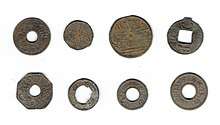Palembang pitis
The Palembang pitis was a currency issued by the Palembang Sultanate from the year 1659 under the reign of Sultan Abdulrrahman Khaifatul Mukminin Sayidul Imam[1] until the sultanate was dissolved by the Dutch in 1823 and the territory was fully integrated into the Dutch East Indies.

Official issues had to be approved by the sultan of Palembang, Most pitis had an inscription like al Sultan fi balad Palembang sanat [date] (the sultan of Palembang year [date]) written in Malay but none actually featured the name of the ruling sultan meaning that pitis coins can only be dated using the Islamic calendar (which began in 622 AD with Mohammad’s Hijra using "AH" ["Anno Hegirae"/"After Hijra"] dates).[2][3] However in many cases the production was outsourced to the local Chinese population, who did not use Arabic script but Traditional Chinese characters and also used Chinese production technology to manufacture pitis coins. Generally speaking most Palembang pitis were made from tin alloyed with lead (except for a single bronze issue), the pitis coins of Palembang could be divided into two categories based on the fact if they were holed or not, the holed ones were known as pitis teboh and the coins without a hole were known as pitis buntu (or pitis bountou). The pitis teboh were strung together like Chinese cash coins which had already been circulating in the archipelago while the non-holed coins were packaged in leaves to form a box known as a kupat. The value of the pitis was based on both the Spanish dollar and the VOC duiten. The pitis teboh were strung together in strings of 500 coins on rotan and a string was referred to as a chuchub, while the pitis buntu were packaged per 250 coins in a kupat. During the colonial era a kupat was worth 20 duiten or 1⁄16 Spanish dollar while a chuchub was worth 40 duiten or 1⁄8 Spanish dollar.[4]
The value of the units of the pitis was also dependent on the actual size of the coins, with the standard size of the pitis teboh being around fifteen millimeters. However as most pitis coins were either in a box of leaves or strung together very tightly most traders couldn't see the coins and their value was very much dependent on an act of trust.[4] This explains why some unofficially produced pitis coins were very crude (and even why some were actually made without features), this is as small low value coins within strings or boxes of leaves would not have been examined too carefully by those handling them.[2]
Manufacture
The pitis teboh were cast in the same way as Chinese cash coins being molten into "coin trees"and then the individual pitis teboh coins were broken off the trunks. Because of this it is quite common today to find a remnant of the original stem that attached the pitis teboh coin to the trunk. The quality of these pitis coins of often high while those of inferior qualities aren’t that hard to find.[2]
It seems the degree of care employed in the manufacture of pitis teboh coins varied greatly. (There are often "wood-grain"-like striations found on them, which is probably due to deteriorated moulds and may also be due to incomplete flans). Many pitis coins, too, were "unofficial" (illegally cast by counterfeiters), with their quality even more problematic than the government made ones. H.C. Millies talks of pitis coins being produced privately with the permission of the sultan, but also mentions hands being cut off for unauthorized enterprise.[2]
See also
References
- "PITISCOIN™ : CONNECTING THE FUTURE TECHNOLOGY". Pitiscoin.asia. 2019. Retrieved 24 March 2019.
- Frank S. Robinson (frank@fsrcoin.com) (2015). "PALEMBANG COINS". ANCIENT COINS/WORLD COINS - FRANK S. ROBINSON. Retrieved 24 March 2019.
- The trustees of the British Museum. (2019). "Brass pitis (cash) of the Sultanate of Palembang ". Google Arts & Culture. Retrieved 24 March 2019.
- De Munten van Nederlandsch Indië by Netscher and Van der Chijs (in Dutch).
Sources
- Recherches sur les monnaies des indigènes de l'archipel Indien et de la pèninsule Malaie by Henricus Christiaan Millies, 1871 (in French). Hosted on Wikimedia Commons.
External links
- Palembang 1659-1823 (Zeno Oriental Coins Database).
| Wikimedia Commons has media related to Palembang pitis. |
.jpg)